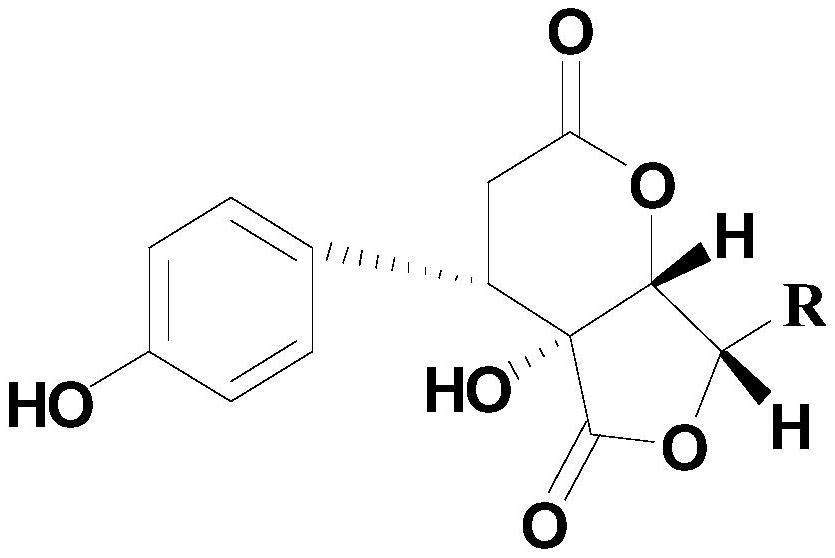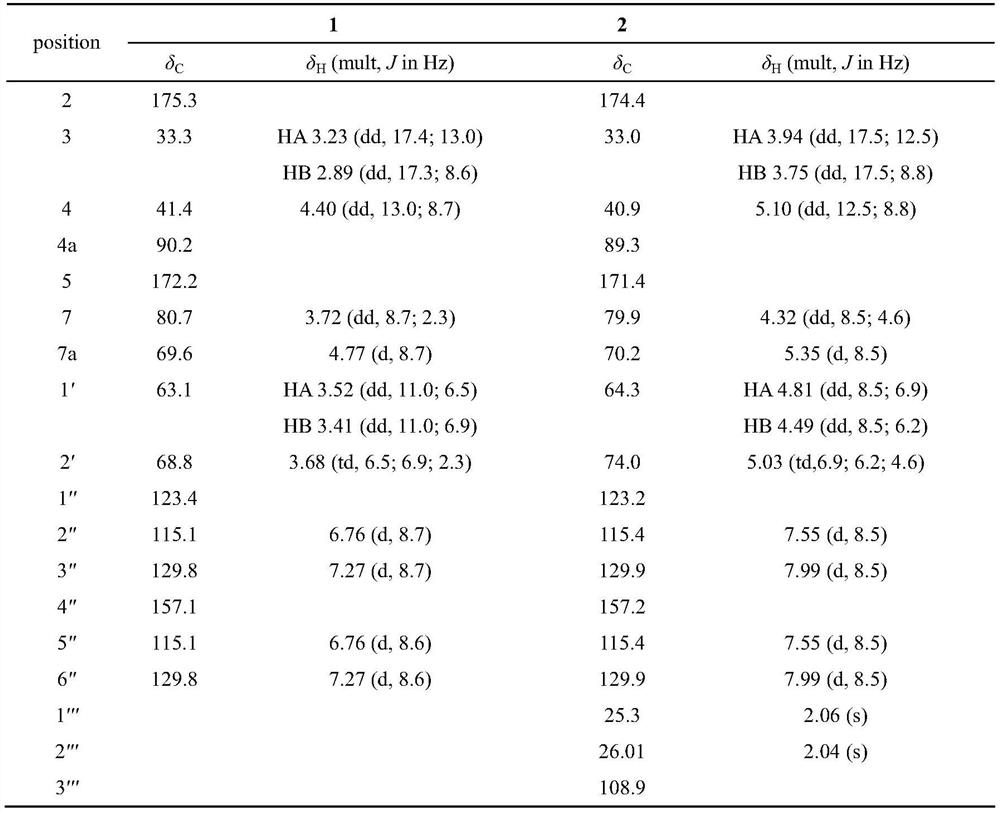Phenyl bis-lactone compounds and their use in the preparation of anti-complement drugs
A compound, dilactone technology, applied in the field of traditional Chinese medicine pharmaceuticals, can solve problems such as excessive activation of the autoimmune system
- Summary
- Abstract
- Description
- Claims
- Application Information
AI Technical Summary
Problems solved by technology
Method used
Image
Examples
Embodiment 1
[0027] Embodiment 1. Preparation of phenyl bis lactone compounds
[0028] Take Polygonum chinense Linn. 10kg medicinal material, pulverize it, and extract it by cold immersion in 95% ethanol for 3 times. After the extract is concentrated, it is suspended in water, and extracted with petroleum ether, ethyl acetate, and n-butanol respectively to obtain the active part positive Butanol 300g, get the extractant 250g and wet the macroporous resin D101 with H 2 O / EtOH (30, 60, 95%, v / v) obtained three fractions Fr.B1-Fr.B3. The active fraction passed through ODS C 18 Medium pressure flash preparative column with CH 3 OH-H 2 O (25:75 to 100:0) was eluted to obtain 7 Fr.B2fractions (A-G). All fractions were purified by semi-preparative column, and compound maysedilactone C (1) and compound maysedilactone D (2) were obtained from Fr. B2fraction A (CH 3 CN-H 2 O-CH 3 COOH 25:75:0.05);
[0029] After further identification, the NMR data of the obtained compounds 1 and 2 are shown...
Embodiment 2
[0030] Example 2. Anti-complement classical pathway experiment in vitro
[0031]Take 0.1 mL of complement (guinea pig serum), add barbiturate buffer solution (BBS) to prepare a 1:10 solution, and double-dilute with BBS to 1:20, 1:40, 1:80, 1:160, 1:10 320, 1:640 and 1:1280 solutions. Take 1:1000 hemolysin, 0.1mL of each concentration of complement and 2% sheep red blood cells (SRBC) and dissolve them in 0.3mL BBS, mix well, put them in a low-temperature high-speed centrifuge at 5000rpm and 4℃ in a 37℃ water bath for 30min Centrifuge for 10 min. Take 0.2 mL of the supernatant from each tube and place it in a 96-well plate, and measure its absorbance at 405 nm. At the same time, a complete hemolysis group (0.1 mL 2% SRBC dissolved in 0.5 mL triple distilled water) was set up in the experiment. The absorbance of three-distilled water lysed blood vessels was used as the standard of total hemolysis, and the hemolysis rate was calculated. Plot the dilution of complement on the x...
Embodiment 3
[0032] Example 3. Anti-complement alternative pathway experiment in vitro
[0033] Take complement (human serum) 0.2mL, add AP diluent (barbital buffer, pH 7.4, containing 5mM Mg 2+ , 8mMEGTA) was double-diluted into 8 concentration gradients (1:2, 1:4, 1:8, 1:16, 1:32, 1:64, 1:128, 1:256), and then hemolyzed In the reaction system, 0.15mL of various concentrations of complement and 0.2mL of 0.5% RRBC were dissolved in 0.35mL of AP diluent, mixed evenly, placed in a low-temperature high-speed centrifuge at 5000rpm, 4°C for 10min in a 37°C water bath for 30min. Take 0.2 mL of the supernatant from each tube and place it in a 96-well plate, and measure the absorbance at 405 nm. At the same time, a complete hemolysis group (0.5% RRBC 0.2mL dissolved in 0.5mL triple distilled water) was set up in the experiment. The absorbance of three-distilled water lysed blood vessels was used as the standard of total hemolysis, and the hemolysis rate was calculated. Take the dilution factor ...
PUM
 Login to View More
Login to View More Abstract
Description
Claims
Application Information
 Login to View More
Login to View More - R&D
- Intellectual Property
- Life Sciences
- Materials
- Tech Scout
- Unparalleled Data Quality
- Higher Quality Content
- 60% Fewer Hallucinations
Browse by: Latest US Patents, China's latest patents, Technical Efficacy Thesaurus, Application Domain, Technology Topic, Popular Technical Reports.
© 2025 PatSnap. All rights reserved.Legal|Privacy policy|Modern Slavery Act Transparency Statement|Sitemap|About US| Contact US: help@patsnap.com



